Ipswich residents will remember a collector's bookshop at 17 St Stephens Lane (a lane running from Old Cattle Market to Buttermarket leading to St Stephen's Church, now the Tourist Information Centre). They may not know that the beautiful half timbered building is one of the historic gems of Ipswich. Note that the bell bollard seen on the photographs below (near the vulnerable corner of the building) features on our King Street page with images of a similar bollard in Arcade Street.
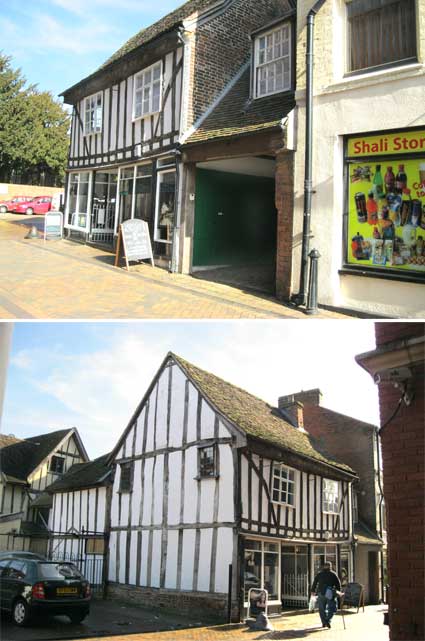 2012 images
2012 imagesFor more about the bell bollard, controversially installed near the corner of the building to protect it from heavy lorries making deliveries to other premises, see our King Street page.
It was only in February 2012 that we passed the courtyard entry to the right of the shop frontage and noticed that it qualifies for our public lettering website: the familiar nameboard which was fixed outside for years is hanging just under the ceiling.
'17
... ATFIELD & DAUGHTER ... 17'
It
seems that any empty shop
premises in Ipswich automatically becomes a hairdresser's business (it
use to be a mobile telephone emporium and before that a shoe shop).
Thank goodness that this building is no exception.
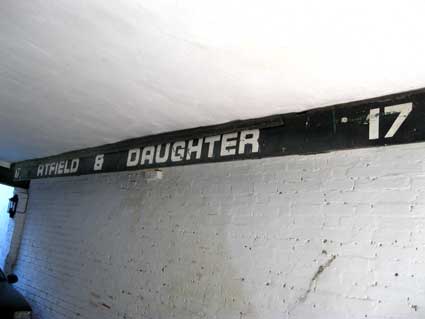
Sneaking into the entry (perhaps a narrow back lane which might have been longer at one time), we photographed the emblematic sun motif, the relief work picked out in golden yellow, on the lane/courtyard wall and noticed a second metallic sun above it (see inset of the image below). Compare with the metal 'Sun' fire plate on the Ancient House. It is not known whether this feature is a fire plate, placed there by one of the early fire insurance companies – it seems too big for that purpose, and sited too high up beneath the eves of the building.
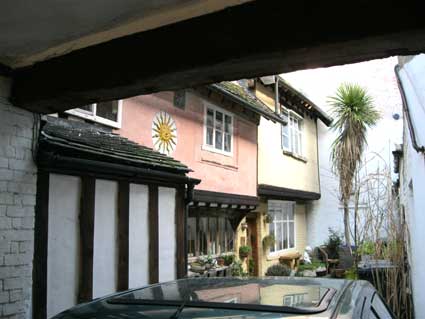
The timber-framed No. 17 was once a merchant's house erected in the 16th, possibly even the 15th, century and would have been part of rows of buildings crowding on either side of St Stephen's Lane. No. 17 now faces the blank wall of Buttermarket Shopping Centre. The house was converted to an inn around 1560. Refurbished in 1720, it stood next to a gabled rectory, presumably for the nearby church. When the cattle market was moved to the site of the current country bus station in 1810 it became the Sun Inn. However, in 1795 the 'Ancient and Most Venerable Order of the Druids' held a meeting there, 'at the house of Brother Willam Phillips at the sign of the Sun inn'. Once the market moved to Princes Street (opposite the Greyfriars tower) business fell away and it closed in 1901.
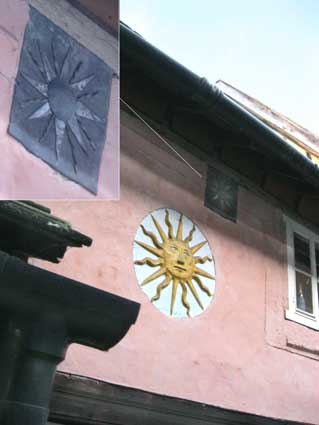
The goldmine of information on the Suffolk CAMRA site (see Links) tells us that it opened as an inn in 1720 (this differs from the much earlier date of 1560 stated above) and closed c.1917; it was previously known as The Rising Sun. It became used extensively by drovers and cattle-dealers after the old cattle market took over a nearby site used previously as a Timber Market. It is currently a Listed building: Grade II. The premises were listed in the 1844 White's Directory with carriers operating from the inn to Diss. Sometime in late 1880s the building was much reduced in size when Dog's Head Street was widened and straightened for trams. For many years after closing as an inn the building was used as an antique shop by Mr Silburn and others.
Restoration work
During the 1960s the building was purchased by the Atfield family and became an antiques and specialist bookshop, closing eventually in 1998. The work on the building has become a labour of love for Doug Atfield, his family and their friends over the years; visitors during the Heritage Open Days in Ipswich have been fascinated by the intimate rooms gradually revealing their secrets whilst they (the visitors) were treated to tea and cakes. When we visited some years ago, an old, angled mirror had been mounted outside the ground floor room facing the courtyard to reflect the image of the, as yet, unrestored sun sign above. The Ipswich Society Newsletter, January 2003, carries an evocative description of the works carried out here:
"Two major hold-ups have delayed fresh progress ... The first in the form of a ten foot long by eight inch square wall plate in the north wall of the upstairs long room. Though inspected and thought to be sound, it proved to be unsound with both rot and worm in its one hidden part. This was a family 'all hands' call, with a lot of weight and awkward manoeuvring involved, unfortunately forcing us to re-do some previously finished work. The second hold-up was that I fell off a ladder and broke an ankle, wasting the best part of seven weeks. The team worked even harder and faster, removing the irreparable lath and plaster ceiling from the front shop exposing the timbers once again...
"The final 'big dig' under the long room (middle room ground floor) has just been completed. This was a dual-purpose dig, first to remove tons of earth from beneath the rotting floor to allow air circulation under the new floor, and secondly as an archaeological survey. Every trowel-full of soil was sifted and the resulting finds are on display. We are indebted to Keith Wade, Tom Loader and Sue Anderson of the County Archaeological Department who logged and plotted the finds and identified most of the shards of pottery which may eventually help to establish the history of the site. Also during the dig an early red brick foundation twenty inches wide was found, running northwards from the north wall of the long room.
"In digging down further, we discovered a complete skeleton of a 12th century male aged 30-34 years, and evidence of at least two other graves. These were identified as Christian burials, and so we can assume that the Sun Inn was built on part of the St Stephen's churchyard, which has shrunk considerably over the years. The skeleton was left in situ and the grave was re-filled with the minimum of disturbance. This has caused us to reappraise the age of 'Freda' who we now believe to be contemporary with these latest discoveries, and not Saxon as first thought. It would now appear that the Saxon graveyard is confined to the Buttermarket (west) side of St Stephen's Lane, whilst the eastern side is a separate Christian site.
"Further work during the year has been the re-opening of an early glassless mullion window (upstairs long room) which has brightened a dull comer ... In the room next to this, up a step, the lath and plaster ceiling has been saved by the laborious process of supporting it with about two hundred screws and large washers..."
Visitors will have been shocked to learn that some ten days before Heritage Open Days, Sheila's husband (Sheila of Atfield and Daughter days) Derek Jeffery, had died. This was of course a dreadful loss to Sheila and the whole family, who, like the troupers they are, rallied round and provided a full visitor service over both Saturday and Sunday. Not many of us would have managed that.
The above passage was taken from an article by Tom Gondris in The Ipswich Society Newsletter, January 2003.
Pottery from AD 650 has been discovered and a skeleton found beneath the floor (covered by many layers of sand which over the years had dropped through the floorboard cracks when it was a 'spit and sawdust' pub) which may relate to burials outside St Stephens Church (which is mentioned in the Domesday Book). It is said that some very interesting items have been found within, such as a hidden cellar (between the ground floor and the basement), a 19th century carbon coated ice box, and various mummified beasts, including a mouse, a bat and a rat.
[UPDATE 1.10.2018: 'I was very interested to read your article about the Sun Inn at 17 St Stephens Lane Ipswich. My Great Uncles, Charles and William Silburn were, I believe, the Silburns who had the Antique shop in The early 1900s. The Silburn family had two brothers and many sisters but as the two brothers had no children the Antique business was sold to A.G. Voss in the 60s or 70s. Sadly the last Silburn, Gladys, passed away about 12 years ago and with her the name. I would be very interested to learn more information about the antique shop if you have any. Kind regards, Allen Gerrard' Many thanks to Allen for prompting us to do a little more research (shown here).]
Masonic Hall
'A NEW exhibition has opened in Ipswich highlighting the town's medieval history. Hidden Treasures of the Buttermarket, which runs until Friday June 19, will give unprecedented access a number of unseen items in the Buttermarket area. The exhibition is located in the Old Sun Inn (formerly the bookshop Atfield and Daughter), the Buttermarket Shopping Centre, Ipswich Building Society and the Tourist Information Centre.
Among the items on display are historic deeds dating back to 1669 which show pledges from masons to fund the building of the Old Sun Inn, which was originally built as a Masonic Hall. There are also items from the cellar of the building which were discovered during recent excavation work.
The exhibition is free to the public with any donations given to the St Elizabeth Hospice. The Buttermarket was the site of a major archaeological dig between 1988 and 1990 before the new shopping centre was built. It is one of the most historic areas of the town – it was part of the original Gipswic settlement founded by the Anglo-Saxons in the seventh century. The town expanded inland after originally being founded near the river – and the Buttermarket site was some of the driest land near the river. Over the centuries this area became one of busiest in Ipswich – and it was at the heart of the medieval town.'
(Evening Star, 5 June 2003, www.ipswichstar.co.uk/news/history-comes-to-life-in-ipswich-1-134234)
See our Soane Street page for the current and previous Masonic Lodges; the previous Lodge is only a few yards from the Sun Inn in St Stephens Church Lane.
Interior
During the Heritage Open Weekend in September 2014, although not strictly part of the event, the empty and, by now, fully restored interior could be viewed. This was prior to a new tenant moving into the shop, a fancy dress hire business. This was too good an opportunity to miss, so the following photographs record the rooms and spaces within.
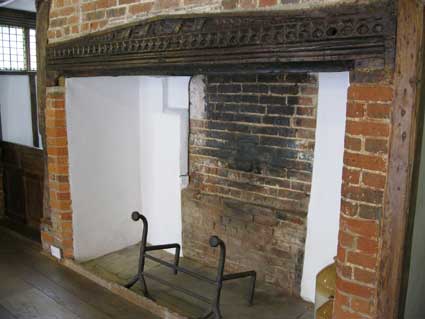
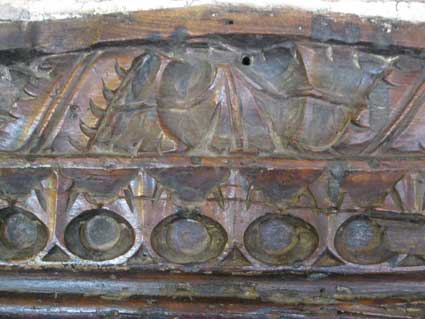 2014 images
2014 imagesThe large, high-status fireplace on the ground floor with a detail of the carving.


The notice pinned in the gothic arch reads:
'This doorway was discovered during restoration. it was hidden beneath layers of lathe and plaster. We think it led to an outer covered stairway and down into yard. But when the building was converted to "The Sun Inn" the existing "inner" staircase was built, this enabled the yard/passage to be widened allowing easier access to rear of building for horse drawn vehicles where there was stabling for 12 horses, which was lost after Sun Inn was closed and sold on 31st January 1901. Because then the property was divided up.
At the same time as the new staircase was constructed 18 to 24 inches was sliced off the south end of the building removing the timber frame end (which once matched the north end) – the timber frame end was replaced with brickwork walls and chimney stack.'
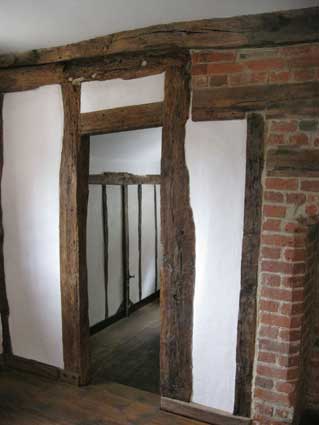

Above: insect damage to the ancient timbers; below: hand-painted decorative frieze on the plasterwork.
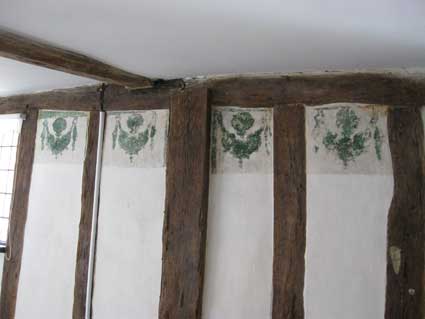
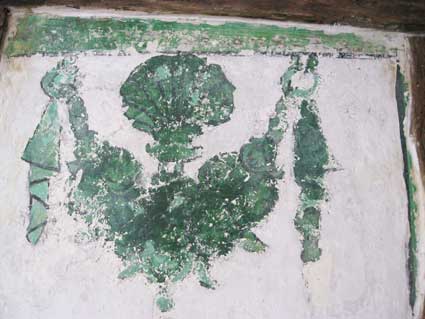
Roofspace timber structure.
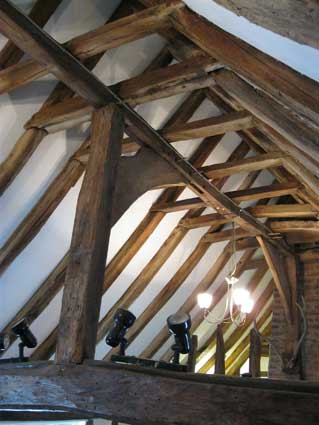
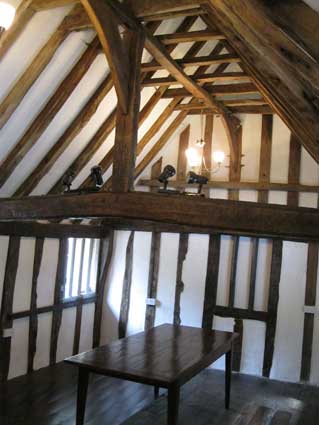
The sun and the fire-plate in the yard
This fresh view of the moulded and painted Sun in the yard boasts striking blue eyes. Doug Atfield tells us that the metal sun emblem above it is a fire-plate insurance sign – a happy coincidence. See our page for the nearby Ancient House for more on fireplates, also the Sun Alliance building in 35 Princes Street.
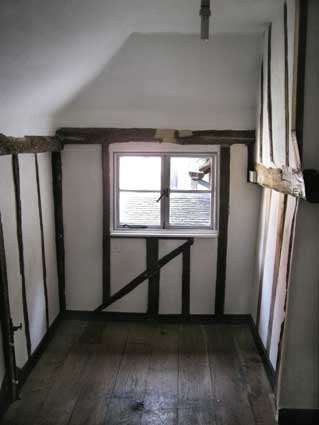

It is only a few steps from here to St Stephen's Church, now the Tourist Information Centre, which bears traces of a famous Ipswich name: Sir Thomas Rush.
These remarkable posters for performances at The Lecture Hall (1881) in Tower Street and The Theatre Royal, Ipswich (1856) were hung in an upper room. Full transcriptions can be found below. Intriguingly, they are printed on silken material.
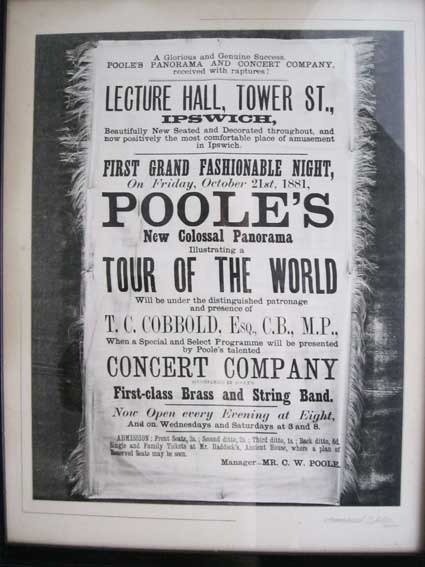
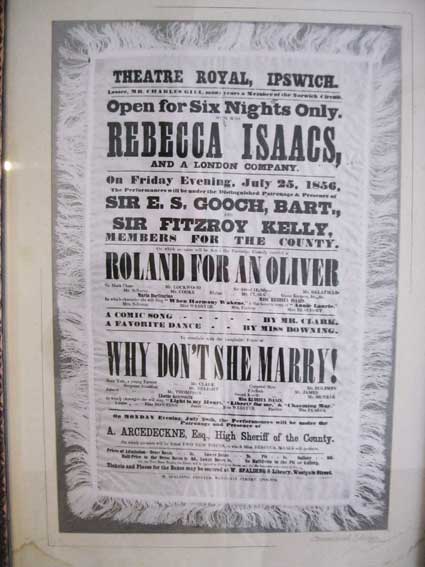
‘A Glorious and Genuine Success.
POOLE’S PANORAMA AND CONCERT COMPANY,
received with raptures!
———————————————
LECTURE HALL, TOWER STREET.,
IPSWICH,
Beautifully New Seated and Decorated throughout, and
now positively the most comfortable place of amusement
in Ipswich.
———————————————
FIRST GRAND FASHIONABLE NIGHT,
On Friday, October 21st, 1881,
POOLE’S
New Colossal Panorama
Illustrating a
TOUR OF THE WORLD
Will be under the distinguished patronage
and presence of
T.C. COBBOLD, ESQ., C.B., M.P.,
When a Special and Select Programme will be presented
by Poole’s talented
CONCERT COMPANY
ACCOMPANIED BY POOLE’S
First-class Brass and String Band.
————————————————
Now Open every Evening at Eight,
And on Wednesdays and Saturdays at 3 and 8.
————————————————
Admission: Front Seats, 3s. ; Second ditto, 2s. ; Third ditto, 1s. ; Back ditto, 6d.
Single and Family Tickets at Mr. Haddock’s, Ancient House, where a plan of
Reserved Seats may be seen.
Manager _ MR. C. W. POOLE.’
POOLE’S PANORAMA AND CONCERT COMPANY,
received with raptures!
———————————————
LECTURE HALL, TOWER STREET.,
IPSWICH,
Beautifully New Seated and Decorated throughout, and
now positively the most comfortable place of amusement
in Ipswich.
———————————————
FIRST GRAND FASHIONABLE NIGHT,
On Friday, October 21st, 1881,
POOLE’S
New Colossal Panorama
Illustrating a
TOUR OF THE WORLD
Will be under the distinguished patronage
and presence of
T.C. COBBOLD, ESQ., C.B., M.P.,
When a Special and Select Programme will be presented
by Poole’s talented
CONCERT COMPANY
ACCOMPANIED BY POOLE’S
First-class Brass and String Band.
————————————————
Now Open every Evening at Eight,
And on Wednesdays and Saturdays at 3 and 8.
————————————————
Admission: Front Seats, 3s. ; Second ditto, 2s. ; Third ditto, 1s. ; Back ditto, 6d.
Single and Family Tickets at Mr. Haddock’s, Ancient House, where a plan of
Reserved Seats may be seen.
Manager _ MR. C. W. POOLE.’
‘THEATRE
ROYAL, IPSWICH.
Lessee, MR. CHARLES GILL, many years a Member of the Norwich Circuit.
Open for Six Nights Only.
WITH MISS
REBECCA ISAACS,
AND A LONDON COMPANY.
—————————————————
On Friday Evening, July 25, 1856,
The Performances will be under the Distinguished Patronage & Presence of
SIR E.S. GOOCH, BART.,
AND
SIR FITZROY KELLY,
MEMBERS FOR THE COUNTY.
—————————————————
On which occasion will be Acted the Favourite Comedy entitled a
ROLAND FOR AN OLIVER
Sir Mark Chase … Mr. LOCKWOOD Sir Alfred Highflyer … Mr. DELAFIELD
Mr. Selborne … Mr. COOKE Fixture … Mr. CLARK Game Keepers &c. &c.
Marian Darlington … … … MISS REBECCA ISAACS
In which Character she will Sing “When Harmony Wakens,” & the favourite song of “Annie Laurie.”
Mrs. Selborne … Miss WEBSTER Mrs. Fixture … Miss BEAUFORT
—————————————————
A COMIC SONG - - - - BY MR. CLARK.
A FAVOURITE DANCE - - - BY MISS DOWNING.
—————————————————
To conclude with the Laughable Farce of
WHY DON’T SHE MARRY!
Natz Teik … Mr. CLARK Corporal Max … Mr. DOLPHIN
Sergeant Standfast … Mr. DELIGHT Firelock … Mr. JAMES
Jobson … Mr. THOMPSON Sword Knott … Mr. DUNBAR
Lisette Gelerstein … Miss REBECCA ISAACS.
in which character she will sing “Light is my heart,” “Liberty for me,” & “Charming May.”
Louise … Miss DOWNING Janet … Miss WEBSTER Pauline … Miss PEARCE
—————————————————
On MONDAY Evening, July 28th, the Performance will be under the
Patronage & Presence of
A. ARCEDECKNE, Esq., High Sheriff of the County.
On which occasion will be Acted TWO NEW PIECES, in which Miss REBECCA ISAACS will perform.
—————————————————
Prices of Admission–Dress Boxes - - 3s. Lower Boxes - - 2s. Pit - - 1s. Gallery - - 6d.
Half-Price to the Dress Boxes 1s. 6d., Lower Boxes 1s. No Half-Price to the Pit or Gallery.
On the Two Race Nights the Doors will be opened at Half-past Seven and the Performance will begin at Eight.
Tickets and Places for the Boxes may be secured at W. SPALDING’S Library, Westgate Street.
—————————————————
W. SPALDING, PRINTER, WESTGATE STREET, IPSWICH.'
Lessee, MR. CHARLES GILL, many years a Member of the Norwich Circuit.
Open for Six Nights Only.
WITH MISS
REBECCA ISAACS,
AND A LONDON COMPANY.
—————————————————
On Friday Evening, July 25, 1856,
The Performances will be under the Distinguished Patronage & Presence of
SIR E.S. GOOCH, BART.,
AND
SIR FITZROY KELLY,
MEMBERS FOR THE COUNTY.
—————————————————
On which occasion will be Acted the Favourite Comedy entitled a
ROLAND FOR AN OLIVER
Sir Mark Chase … Mr. LOCKWOOD Sir Alfred Highflyer … Mr. DELAFIELD
Mr. Selborne … Mr. COOKE Fixture … Mr. CLARK Game Keepers &c. &c.
Marian Darlington … … … MISS REBECCA ISAACS
In which Character she will Sing “When Harmony Wakens,” & the favourite song of “Annie Laurie.”
Mrs. Selborne … Miss WEBSTER Mrs. Fixture … Miss BEAUFORT
—————————————————
A COMIC SONG - - - - BY MR. CLARK.
A FAVOURITE DANCE - - - BY MISS DOWNING.
—————————————————
To conclude with the Laughable Farce of
WHY DON’T SHE MARRY!
Natz Teik … Mr. CLARK Corporal Max … Mr. DOLPHIN
Sergeant Standfast … Mr. DELIGHT Firelock … Mr. JAMES
Jobson … Mr. THOMPSON Sword Knott … Mr. DUNBAR
Lisette Gelerstein … Miss REBECCA ISAACS.
in which character she will sing “Light is my heart,” “Liberty for me,” & “Charming May.”
Louise … Miss DOWNING Janet … Miss WEBSTER Pauline … Miss PEARCE
—————————————————
On MONDAY Evening, July 28th, the Performance will be under the
Patronage & Presence of
A. ARCEDECKNE, Esq., High Sheriff of the County.
On which occasion will be Acted TWO NEW PIECES, in which Miss REBECCA ISAACS will perform.
—————————————————
Prices of Admission–Dress Boxes - - 3s. Lower Boxes - - 2s. Pit - - 1s. Gallery - - 6d.
Half-Price to the Dress Boxes 1s. 6d., Lower Boxes 1s. No Half-Price to the Pit or Gallery.
On the Two Race Nights the Doors will be opened at Half-past Seven and the Performance will begin at Eight.
Tickets and Places for the Boxes may be secured at W. SPALDING’S Library, Westgate Street.
—————————————————
W. SPALDING, PRINTER, WESTGATE STREET, IPSWICH.'
See our Old Cattle Market page for a 1674 map of the area.
©2004 Copyright throughout the Ipswich Historic Lettering site: Borin Van Loon
No reproduction of text or images without express written permission